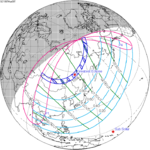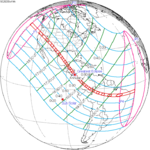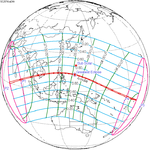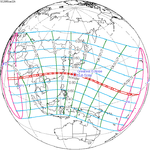Solar eclipse of December 26, 2019
| Solar eclipse of December 26, 2019 | |
|---|---|
 Annularity as seen from Jaffna, Sri Lanka | |
| Type of eclipse | |
| Nature | Annular |
| Gamma | 0.4135 |
| Magnitude | 0.9701 |
| Maximum eclipse | |
| Duration | 220 s (3 min 40 s) |
| Coordinates | 1°00′N 102°18′E / 1°N 102.3°E |
| Max. width of band | 118 km (73 mi) |
| Times (UTC) | |
| Greatest eclipse | 5:18:53 |
| References | |
| Saros | 132 (46 of 71) |
| Catalog # (SE5000) | 9552 |
An annular solar eclipse occurred at the Moon’s descending node of orbit on Thursday, December 26, 2019,[1][2][3][4][5] with a magnitude of 0.9701. A solar eclipse occurs when the Moon passes between Earth and the Sun, thereby totally or partly obscuring the Sun for a viewer on Earth. An annular solar eclipse occurs when the Moon's apparent diameter is smaller than the Sun's, blocking most of the Sun's light and causing the Sun to look like an annulus (ring). An annular eclipse appears as a partial eclipse over a region of the Earth thousands of kilometres wide.[6] The Moon's apparent diameter was near the average diameter because it occurred 7.3 days after perigee (on December 18, 2019, at 20:25 UTC) and 6.2 days before apogee (on January 2, 2020, at 1:30 UTC).[7]
Annularity was visible in Saudi Arabia, Qatar, United Arab Emirates, Oman, southern India, Sri Lanka, Malaysia, Indonesia, Singapore, the Northern Mariana Islands, and Guam. A partial eclipse was visible for parts of East Africa, Asia, and northern Australia.
Visibility and viewing
[edit]
It was the last solar eclipse of 2019. The central path of the 2019 annular eclipse passed through the Saudi Arabian peninsula, southern India, Sumatra, Borneo, Philippines and Guam. A partial eclipse was visible thousands of kilometers wide from the central path. It covered small parts of Eastern Europe, much of Asia, North and West Australia, Eastern Africa, the Pacific Ocean and the Indian Ocean.[6][8] The eclipse started with an antumbra having a magnitude of 0.96; it stretched 164 kilometers wide, and traveled eastwards at an average rate of 1.1 kilometers per second. The longest duration of annularity was 3 minutes and 40 seconds, at 5.30 UT1 occurring in the South China Sea (0°45'54.0"N 105°29'06.0"E).[6]

The eclipse began in Saudi Arabia about 220 kilometers northeast of Riyadh at 03:43 UT1 and ended in Guam at 06:59.4 UT1. It reached India near Kannur, Kerala, at 03:56 UT1. The shadow reached the southeast coast of India at 04:04 UT1. Traveling through northern Sri Lanka, it headed into the Bay of Bengal. The next main visible places were Palau (Malaysia), Sumatra and Singapore. It then passed through the South China Sea, crossed Borneo and the Celebes Sea, the Philippines archipelago and then headed towards the western Pacific. The antumbral shadow encountered Guam at 6:56 UT1 and rose back into space.[6]
Gallery
[edit]-
Partial from Nabih Saleh, Bahrain, 3:32 UTC
-
Partial from Kuwait City, 3:52 UTC
-
Partial from Kochi, India, 3:59 UTC
-
Nilambur, India, 3:59 UTC
-
Mangalore, India, 4:16 UTC
-
Partial from Dhaka, Bangladesh, 5:13 UTC
-
Partial from Jakarta, Indonesia, 5:18 UTC
-
Labrador Nature Reserve, Singapore, 5:23 UTC
-
Partial from University of Science, Malaysia, 5:25 UTC
-
Batam, Indonesia, 5:25 UTC
-
Tanjungpinang, Indonesia, 5:25 UTC
-
Partial from Hefei, China, 6:18 UTC
-
Partial from San Jose del Monte, Philippines, 6:19 UTC
-
Partial from Digos, Philippines, 6:21 UTC
-
Merizo, Guam, 6:56 UTC
-
Eclipse progression from Batam, Indonesia
Eclipse details
[edit]Shown below are two tables displaying details about this particular solar eclipse. The first table outlines times at which the moon's penumbra or umbra attains the specific parameter, and the second table describes various other parameters pertaining to this eclipse.[9]
| Event | Time (UTC) |
|---|---|
| First penumbral external contact | 2019 December 26 at 02:31:00.8 UTC |
| First umbral external contact | 2019 December 26 at 03:35:41.7 UTC |
| First central line | 2019 December 26 at 03:37:13.6 UTC |
| First umbral internal contact | 2019 December 26 at 03:38:45.8 UTC |
| First penumbral internal contact | 2019 December 26 at 05:02:35.5 UTC |
| Ecliptic conjunction | 2019 December 26 at 05:14:17.0 UTC |
| Equatorial conjunction | 2019 December 26 at 05:15:43.8 UTC |
| Greatest eclipse | 2019 December 26 at 05:18:53.1 UTC |
| Greatest duration | 2019 December 26 at 05:29:39.4 UTC |
| Last penumbral internal contact | 2019 December 26 at 05:35:14.2 UTC |
| Last umbral internal contact | 2019 December 26 at 06:59:00.2 UTC |
| Last central line | 2019 December 26 at 07:00:35.4 UTC |
| Last umbral external contact | 2019 December 26 at 07:02:10.4 UTC |
| Last penumbral external contact | 2019 December 26 at 08:06:53.4 UTC |
| Parameter | Value |
|---|---|
| Eclipse magnitude | 0.97010 |
| Eclipse obscuration | 0.94110 |
| Gamma | 0.41351 |
| Sun right ascension | 18h17m56.7s |
| Sun declination | -23°22'19.2" |
| Sun semi-diameter | 16'15.7" |
| Sun equatorial horizontal parallax | 08.9" |
| Moon right ascension | 18h18m03.7s |
| Moon declination | -22°58'50.4" |
| Moon semi-diameter | 15'33.0" |
| Moon equatorial horizontal parallax | 0°57'04.0" |
| ΔT | 69.8 s |
Eclipse season
[edit]This eclipse is part of an eclipse season, a period, roughly every six months, when eclipses occur. Only two (or occasionally three) eclipse seasons occur each year, and each season lasts about 35 days and repeats just short of six months (173 days) later; thus two full eclipse seasons always occur each year. Either two or three eclipses happen each eclipse season. In the sequence below, each eclipse is separated by a fortnight.
| December 26 Descending node (new moon) |
January 10 Ascending node (full moon) |
|---|---|
 |

|
| Annular solar eclipse Solar Saros 132 |
Penumbral lunar eclipse Lunar Saros 144 |
Related eclipses
[edit]Eclipses in 2019
[edit]- A partial solar eclipse on January 6
- A total lunar eclipse on January 21
- A total solar eclipse on July 2
- A partial lunar eclipse on July 16
- An annular solar eclipse on December 26
Astronomers Without Borders collected eclipse glasses for redistribution to Latin America and Asia for their 2019 eclipses from the solar eclipse of August 21, 2017.[10]
Metonic
[edit]- Preceded by: Solar eclipse of March 9, 2016
- Followed by: Solar eclipse of October 14, 2023
Tzolkinex
[edit]- Preceded by: Solar eclipse of November 13, 2012
- Followed by: Solar eclipse of February 6, 2027
Half-Saros
[edit]- Preceded by: Lunar eclipse of December 21, 2010
- Followed by: Lunar eclipse of December 31, 2028
Tritos
[edit]- Preceded by: Solar eclipse of January 26, 2009
- Followed by: Solar eclipse of November 25, 2030
Solar Saros 132
[edit]- Preceded by: Solar eclipse of December 14, 2001
- Followed by: Solar eclipse of January 5, 2038
Inex
[edit]- Preceded by: Solar eclipse of January 15, 1991
- Followed by: Solar eclipse of December 5, 2048
Triad
[edit]- Preceded by: Solar eclipse of February 24, 1933
- Followed by: Solar eclipse of October 26, 2106
Solar eclipses of 2018–2021
[edit]This eclipse is a member of a semester series. An eclipse in a semester series of solar eclipses repeats approximately every 177 days and 4 hours (a semester) at alternating nodes of the Moon's orbit.[11]
The partial solar eclipses on February 15, 2018 and August 11, 2018 occur in the previous lunar year eclipse set.
| Solar eclipse series sets from 2018 to 2021 | ||||||
|---|---|---|---|---|---|---|
| Ascending node | Descending node | |||||
| Saros | Map | Gamma | Saros | Map | Gamma | |
117 Partial in Melbourne, Australia |
July 13, 2018 Partial |
−1.35423 | 122 Partial in Nakhodka, Russia |
January 6, 2019 Partial |
1.14174 | |
127 Totality in La Serena, Chile |
July 2, 2019 Total |
−0.64656 | 132 Annularity in Jaffna, Sri Lanka |
December 26, 2019 Annular |
0.41351 | |
137 Annularity in Beigang, Yunlin, Taiwan |
June 21, 2020 Annular |
0.12090 | 142 Totality in Gorbea, Chile |
December 14, 2020 Total |
−0.29394 | |
147 Partial in Halifax, Canada |
June 10, 2021 Annular |
0.91516 | 152 From HMS Protector off South Georgia |
December 4, 2021 Total |
−0.95261 | |
Saros 132
[edit]This eclipse is a part of Saros series 132, repeating every 18 years, 11 days, and containing 71 events. The series started with a partial solar eclipse on August 13, 1208. It contains annular eclipses from March 17, 1569 through March 12, 2146; hybrid eclipses on March 23, 2164 and April 3, 2182; and total eclipses from April 14, 2200 through June 19, 2308. The series ends at member 71 as a partial eclipse on September 25, 2470. Its eclipses are tabulated in three columns; every third eclipse in the same column is one exeligmos apart, so they all cast shadows over approximately the same parts of the Earth.
The longest duration of annularity was produced by member 25 at 6 minutes, 56 seconds on May 9, 1641, and the longest duration of totality will be produced by member 61 at 2 minutes, 14 seconds on June 8, 2290. All eclipses in this series occur at the Moon’s descending node of orbit.[12]
| Series members 34–56 occur between 1801 and 2200: | |||
|---|---|---|---|
| 34 | 35 | 36 | |
 August 17, 1803 |
 August 27, 1821 |
 September 7, 1839 | |
| 37 | 38 | 39 | |
 September 18, 1857 |
 September 29, 1875 |
 October 9, 1893 | |
| 40 | 41 | 42 | |
 October 22, 1911 |
 November 1, 1929 |
 November 12, 1947 | |
| 43 | 44 | 45 | |
 November 23, 1965 |
 December 4, 1983 |
 December 14, 2001 | |
| 46 | 47 | 48 | |
 December 26, 2019 |
 January 5, 2038 |
 January 16, 2056 | |
| 49 | 50 | 51 | |
 January 27, 2074 |
 February 7, 2092 |
 February 18, 2110 | |
| 52 | 53 | 54 | |
 March 1, 2128 |
 March 12, 2146 |
 March 23, 2164 | |
| 55 | 56 | ||
 April 3, 2182 |
 April 14, 2200 | ||
Metonic series
[edit]The metonic series repeats eclipses every 19 years (6939.69 days), lasting about 5 cycles. Eclipses occur in nearly the same calendar date. In addition, the octon subseries repeats 1/5 of that or every 3.8 years (1387.94 days). All eclipses in this table occur at the Moon's descending node.
| 21 eclipse events between May 21, 1993 and May 20, 2069 | ||||
|---|---|---|---|---|
| May 20–21 | March 9 | December 25–26 | October 13–14 | August 1–2 |
| 118 | 120 | 122 | 124 | 126 |
 May 21, 1993 |
 March 9, 1997 |
 December 25, 2000 |
 October 14, 2004 |
 August 1, 2008 |
| 128 | 130 | 132 | 134 | 136 |
 May 20, 2012 |
 March 9, 2016 |
 December 26, 2019 |
 October 14, 2023 |
 August 2, 2027 |
| 138 | 140 | 142 | 144 | 146 |
 May 21, 2031 |
 March 9, 2035 |
 December 26, 2038 |
 October 14, 2042 |
 August 2, 2046 |
| 148 | 150 | 152 | 154 | 156 |
 May 20, 2050 |
 March 9, 2054 |
 December 26, 2057 |
 October 13, 2061 |
 August 2, 2065 |
| 158 | ||||
 May 20, 2069 | ||||
Tritos series
[edit]This eclipse is a part of a tritos cycle, repeating at alternating nodes every 135 synodic months (≈ 3986.63 days, or 11 years minus 1 month). Their appearance and longitude are irregular due to a lack of synchronization with the anomalistic month (period of perigee), but groupings of 3 tritos cycles (≈ 33 years minus 3 months) come close (≈ 434.044 anomalistic months), so eclipses are similar in these groupings.
| Series members between 1801 and 2200 | ||||
|---|---|---|---|---|
 September 8, 1801 (Saros 112) |
 August 7, 1812 (Saros 113) |
 July 8, 1823 (Saros 114) |
 June 7, 1834 (Saros 115) |
 May 6, 1845 (Saros 116) |
 April 5, 1856 (Saros 117) |
 March 6, 1867 (Saros 118) |
 February 2, 1878 (Saros 119) |
 January 1, 1889 (Saros 120) |
 December 3, 1899 (Saros 121) |
 November 2, 1910 (Saros 122) |
 October 1, 1921 (Saros 123) |
 August 31, 1932 (Saros 124) |
 August 1, 1943 (Saros 125) |
 June 30, 1954 (Saros 126) |
 May 30, 1965 (Saros 127) |
 April 29, 1976 (Saros 128) |
 March 29, 1987 (Saros 129) |
 February 26, 1998 (Saros 130) |
 January 26, 2009 (Saros 131) |
 December 26, 2019 (Saros 132) |
 November 25, 2030 (Saros 133) |
 October 25, 2041 (Saros 134) |
 September 22, 2052 (Saros 135) |
 August 24, 2063 (Saros 136) |
 July 24, 2074 (Saros 137) |
 June 22, 2085 (Saros 138) |
 May 22, 2096 (Saros 139) |
 April 23, 2107 (Saros 140) |
 March 22, 2118 (Saros 141) |
 February 18, 2129 (Saros 142) |
 January 20, 2140 (Saros 143) |
 December 19, 2150 (Saros 144) |
 November 17, 2161 (Saros 145) |
 October 17, 2172 (Saros 146) |
 September 16, 2183 (Saros 147) |
 August 16, 2194 (Saros 148) | |||
Inex series
[edit]This eclipse is a part of the long period inex cycle, repeating at alternating nodes, every 358 synodic months (≈ 10,571.95 days, or 29 years minus 20 days). Their appearance and longitude are irregular due to a lack of synchronization with the anomalistic month (period of perigee). However, groupings of 3 inex cycles (≈ 87 years minus 2 months) comes close (≈ 1,151.02 anomalistic months), so eclipses are similar in these groupings.
| Series members between 1801 and 2200 | ||
|---|---|---|
 May 16, 1817 (Saros 125) |
 April 25, 1846 (Saros 126) |
 April 6, 1875 (Saros 127) |
 March 17, 1904 (Saros 128) |
 February 24, 1933 (Saros 129) |
 February 5, 1962 (Saros 130) |
 January 15, 1991 (Saros 131) |
 December 26, 2019 (Saros 132) |
 December 5, 2048 (Saros 133) |
 November 15, 2077 (Saros 134) |
 October 26, 2106 (Saros 135) |
 October 7, 2135 (Saros 136) |
 September 16, 2164 (Saros 137) |
 August 26, 2193 (Saros 138) |
|
Notes
[edit]- ^ "December 26, 2019 Annular Solar Eclipse". timeanddate. Retrieved 12 August 2024.
- ^ Malik, Tariq (December 26, 2019). "'Ring of Fire' Solar Eclipse Thrills Skywatchers Around the World (and in Space, Too!)". Space.com.
- ^ "Solar eclipse creates 'ring of fire' in sky over parts of Asia Dec. 26". ABC7 Chicago. December 26, 2019.
- ^ Chappell, Bill (December 26, 2019). "'Ring Of Fire' Eclipse Sweeps Across Skies In Middle East And Southeast Asia". NPR.com.
- ^ "Egg-standing test goes viral as ring-of-fire eclipse crosses Asia". December 26, 2019 – via www.reuters.com.
- ^ a b c d "EclipseWise - Eclipses During 2019". eclipsewise.com. Retrieved 2019-07-25.
- ^ "Moon Distances for London, United Kingdom, England". timeanddate. Retrieved 12 August 2024.
- ^ "Annular Solar Eclipse on December 26, 2019". www.timeanddate.com. Retrieved 2019-07-25.
- ^ "Annular Solar Eclipse of 2019 Dec 26". EclipseWise.com. Retrieved 12 August 2024.
- ^ Cooper, Gael (2017-08-22). "Wait! Dig those eclipse glasses out of the garbage Here comes the sun. Astronomers Without Borders will be collecting the protective eyewear for use in future eclipses worldwide". Retrieved 2017-08-27.
- ^ van Gent, R.H. "Solar- and Lunar-Eclipse Predictions from Antiquity to the Present". A Catalogue of Eclipse Cycles. Utrecht University. Retrieved 6 October 2018.
- ^ "NASA - Catalog of Solar Eclipses of Saros 132". eclipse.gsfc.nasa.gov.






















